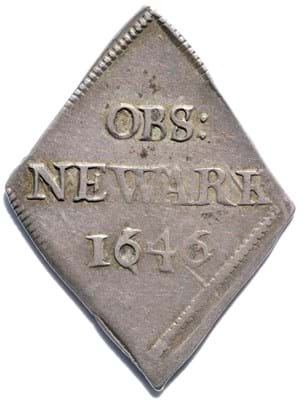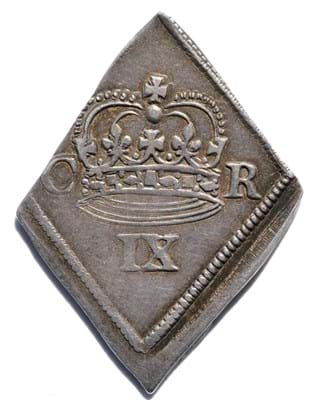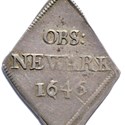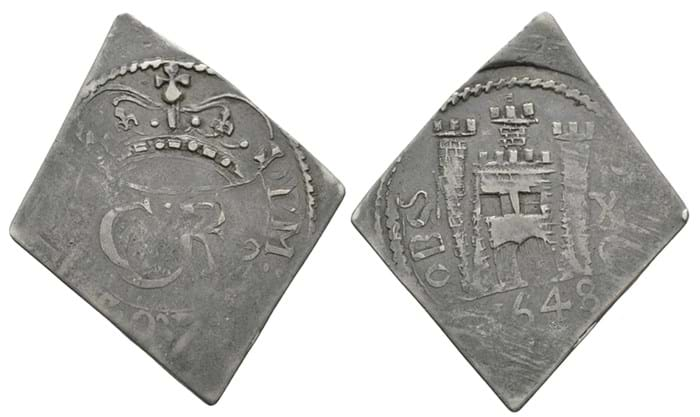One of the latest to come to auction was consigned to North Yorkshire saleroom Tennants by a private source in northern England, estimated at £1000-1500. The nine-pence sold in the July 26 Coins, Tokens & Banknotes sale for a hammer price of £1600 (plus 18.5% buyer’s premium) to a private client from Lincolnshire, bidding in the room.
These silver coins were minted under the reign of Charles I, as emergency coinage when the town was under siege. Newark was a site of strategic importance to both Royalists and Parliamentarians during the civil war, as two major roads – the Great North Road, and the Fosse Way – ran through the town.
Occupied by Royalists during the early years of the war, Newark was besieged by Parliamentarians three times – briefly in 1643 and 1644, and then for a little over five months in 1645-6. It was during this long siege that the Tennants coin was made.
Six-pence, nine-pence, shilling and half-crown coins were all made following the same lozenge shape, and most were created from pieces of metal cut from silver tableware and other decorative objects. The coins were then stamped with the crown, with Roman numerals showing the coin’s value, and with the name of the town.
On the obverse of each Newark coin was struck a large crown, between the initial CR (Carolus Rex), with value, in the Roman numerals, beneath it. The reverse was Obs.[idional] Newark, with the date 1645 or 1646.
According to Tennants, “half-crown siege coins are not uncommon, but the nine-pence is rare, and six-pences are even rarer”.
Regarding how these siege coins developed, an article on newarklocalhistory.org.uk quotes an 1894 article by a local historian, J Potter Briscoe which first appeared in the journal Notts. and Derbyshire Notes and Queries Vol.2, May 1894.
“In addition to the regular coins in use during the troubled times of Charles I, which were of a size and denomination well known as the currency of this kingdom, there were others of irregular form and value struck by Charles and his adherents, in order to supply that sovereign with the means necessary for carrying on the wars. From their being struck in places which were in a state of siege, they have become known to us as ‘siege pieces’, or ‘money of necessity’.”
The nobility and gentry who favoured the Royalist cause “were applied to for the use of their plate, as were also the wardens and fellows of the different colleges in the universities, and the mayors and corporations of cities and towns. This plate was clipped up, for the greatest part, into pieces of varying shapes – oblong, diamond [or lozenge], and round.”
The siege pieces were stamped with “hastily formed devices, intended to represent the castle in which they were struck, or with the name of the place. Other pieces bear an imperfect representation of the place, and in consequence cannot be assigned with certainty. Some of the pieces of silver retain the mouldings of the salvers from which they were clipped.”
The Newark siege coins are the most common.
Coin values in the salerooms
Judging by recent auction results recorded on thesaleroom.com, Newark hammer price values can range from around £200 up to £2500-3000 for the best examples. The denomination itself and, as ever, condition and rarity, are factors.
At the higher end, on November 2016 Hansons sold a 1646 half-crown for a mid-estimate £1900. Among a selection of eight Newark siege coins offered in March 2016, Lockdales sold a 1645 shilling for £2800 (estimate £1800-2000).
In 2015 Baldwin’s had a selection of Newark siege coins on offer. A 1646 half-crown went for £2200 (estimate £1200-1500), while a 1645 shilling made £1650 (£1200-1500) and another took an impressive £2500 (£1500-2000).
Outside Newark
As an example of an English Civil war siege coin minted elsewhere, on May 23 this year TimeLine Auctions sold a 1648 lozenge-shaped Pontefract coin for a mid-estimate £1700.
It shows the castle gateway with flag over a central turret and the OBS on the left.
The catalogue description read: “Pontefract was first besieged by the Parliament forces on December 19, 1644, eventually surrendering in July 1645. The castle was again besieged from June 1648 until it finally surrendered on March 24, 1649, some time after the execution of Charles I and having declared for Charles II in the meantime.
“Two shilling and one shilling lozenge-shaped coins dated 1648 were produced during this second siege to pay the garrison, with octagonal shillings a little later; few examples have survived.”
Gold standards
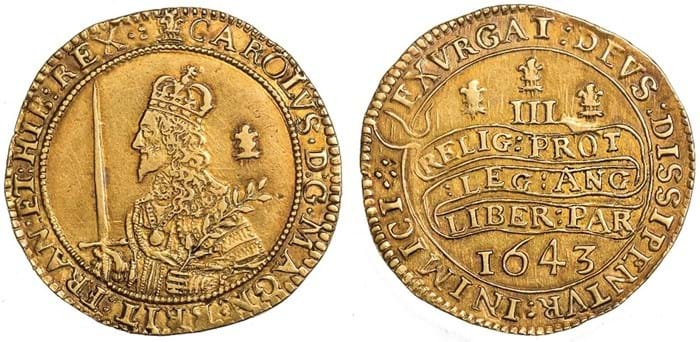
Charles I ‘triple-unite’ gold coin minted in Oxford in 1643 sold on low estimate at £42,500 in the St James’s Auctions (Knightsbridge Coins) April 19 sale last year.
Meanwhile, at a much higher price level, a Charles I ‘triple-unite’ gold coin minted in Oxford in 1643 sold on low estimate at £42,500 in the St James’s Auctions (Knightsbridge Coins) April 19 sale last year.
As the catalogue note said: “In ordinary times throughout England’s thousand-year recorded history no cause ever occurred calling for such a massive and high-purity gold coin as the triple-unite, worth 60 shillings in its day.
“The only reason to create it was war, to pay for mountains of supplies at King Charles’ tentative quarters as he was pursued by Oliver Cromwell’s army. Once he escaped London, his principal holdout was at Oxford, where this fabulous coin was minted. The fortress and mint operated from 1642-46, and the money issued from Oxford varied from ‘small change’ to pay soldiers to large gold.”


